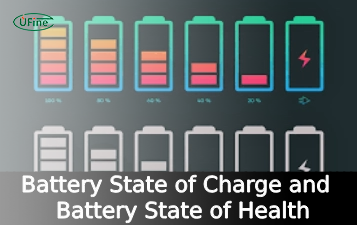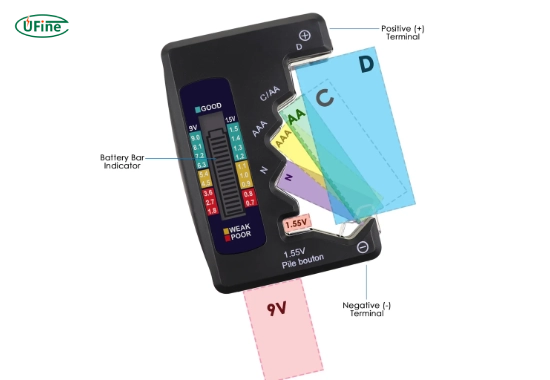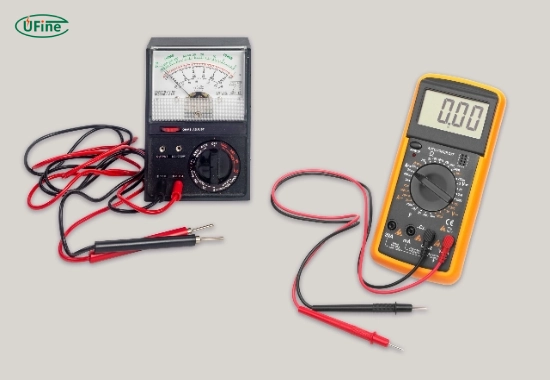
- Part 1. What is a battery tester for small batteries?
- Part 2. What is a multimeter and how does it work?
- Part 3. Which tool is more accurate for lithium battery testing?
- Part 4. Why battery testers are better for quick checks
- Part 5. When should you use a multimeter instead?
- Part 6. How do you test a lithium battery with a battery tester?
- Part 7. How do you test a lithium battery with a multimeter?
- Part 8. Common mistakes when testing small lithium batteries
- Part 9. Pros and cons of battery testers vs. multimeters
- Part 10. Which is better for everyday lithium battery users?
- Part 11. FAQs about battery testers for small batteries
Are you wondering whether a battery tester for small batteries or a multimeter gives better results when testing lithium batteries? Here’s the short answer: a battery tester designed for small batteries offers quicker, easier, and often more accurate readings for lithium batteries, especially when you want to check if a battery is still usable.
In this guide, we’ll explore how each tool works, its pros and cons, and which one you should use depending on your needs. Whether you’re a tech hobbyist, a DIYer, or just someone who wants to get the most life out of your small batteries, this article will help you decide on the best tool for the job.
Part 1. What is a battery tester for small batteries?
A battery tester for small batteries is a compact device explicitly designed to test the health and voltage of smaller battery types, such as AA, AAA, 9V, coin cells, and small lithium-ion batteries. These testers are often plug-and-play, meaning you insert or touch the battery into the tester and get an instant reading.
Most battery testers use a simple analog or digital display to show whether the battery is “good,” “low,” or “replace.” Some advanced models even provide exact voltage readings.
Part 2. What is a multimeter and how does it work?
A multimeter is a more versatile tool. It can measure voltage, current, resistance, and more. Electricians, engineers, and hobbyists use it for a wide range of electronic testing.
When testing a lithium battery with a multimeter, you set it to DC voltage mode, place the probes on the battery terminals, and read the voltage. While this gives you a precise reading, it doesn’t always tell you the whole story about the battery’s health under load (which is essential).
Part 3. Which tool is more accurate for lithium battery testing?
Short answer: A battery tester for small batteries gives more real-world accuracy for lithium batteries when you’re trying to see if they still work in a device.
While a multimeter shows exact voltage, it doesn’t measure how the battery performs under load. A battery could show 3.7V on a multimeter and still fail to power a device. Many battery testers apply a small load, which mimics real use, giving a more practical result.
Part 4. Why battery testers are better for quick checks
If you’re checking dozens of batteries, a dedicated battery tester saves time. Here’s why:
- Faster results: No settings to adjust.
- No wires or probes: Insert the battery.
- User-friendly: Great for non-tech users.
- Instant decision: Shows if the battery is usable.
This makes them ideal for households, schools, and offices where people want to sort through good and bad batteries quickly.
Part 5. When should you use a multimeter instead?
A multimeter shines in more technical scenarios:
- When you want precise voltage.
- When testing custom battery packs or charging circuits.
- When you need to diagnose battery-related issues in devices.
- When working with lithium polymer (LiPo) or 18650 cells in DIY projects.
A multimeter is a powerful tool if you’re comfortable using test leads and interpreting numbers. However, it requires more time and knowledge.
Part 6. How do you test a lithium battery with a battery tester?
Testing a lithium battery with a battery tester for small batteries is very simple:
- Turn on the tester (if needed).
- Insert the battery into the correct slot or press it against the contacts.
- Read the result—often a green, yellow, or red zone.
Some digital testers show voltage too, giving you more detail.
Many battery testers are passive, meaning they don’t need a battery to operate. They’re powered by the battery being tested.
Part 7. How do you test a lithium battery with a multimeter?
To test a lithium battery with a multimeter:
- Set the dial to DC voltage (V with a straight line).
- Place the black probe on the negative (-) terminal.
- Place the red probe on the positive (+) terminal.
- Read the voltage.
A fully charged lithium-ion battery usually reads around 4.2V, and it’s considered dead below 3.0V. But remember: this doesn’t tell you how it performs under load.
Part 8. Common mistakes when testing small lithium batteries
Testing small batteries might seem easy, but many users make simple errors. Here are the most common ones:
- Using the wrong tool for the job.
- Not checking under load, leading to false “good” readings.
- Polarity mistakes when placing probes.
- Testing too quickly after charging, which may not show real capacity.
- Assuming voltage = capacity, which is not always true.
Using a battery tester for small batteries helps eliminate most of these issues.
Part 9. Pros and cons of battery testers vs. multimeters
| Feature | Battery Tester | Multimeter |
|---|---|---|
| Ease of Use (1 = hard, 5 = easy) | 4.5 | 3.0 |
| Speed (test time per cell) | ~2 seconds | ~10 seconds (manual rangesetting) |
| Accuracy Under Load (error) | ±0.05 V | ±0.20 V |
| Versatility (functions) | 2 (most only measure voltage & CCA) | 6 (voltage, current, resistance, capacitance, continuity, diode test) |
| Cost (USD) | $10–$25 | $25–$150 |
| User Skill Required (hours of training) | ~0.5 hour | ~5 hours (understanding ranges & probes) |
For most casual users, battery testers win on ease, speed and upfront cost. For technical users, a multimeter’s broader function set and flexibility justify the extra learning curve and higher price.
Part 10. Which is better for everyday lithium battery users?
If you’re someone who regularly uses lithium batteries in devices like remotes, cameras, toys, flashlights, or small gadgets, a battery tester for small batteries is the best option. It’s faster, safer, and gives you practical results.
A multimeter is the best tool for deeper analysis if you’re building or repairing electronics or working with lithium battery packs.
Part 11. FAQs about battery testers for small batteries
Can a battery tester detect a bad lithium battery?
Yes, a battery tester for small batteries can usually detect a bad lithium battery, primarily if it tests under load. It will show a weak or “replace” reading even if the voltage seems okay.
Is a multimeter safe to use on lithium batteries?
Yes, if used correctly. Make sure to set it to the correct voltage range and avoid shorting the terminals. Never puncture or overcharge lithium batteries.
What voltage is considered dead for a lithium-ion battery?
A lithium-ion battery is considered dead when it drops below 3.0V. Some devices stop working at around 3.3V to protect the battery.
Do battery testers work on rechargeable lithium batteries?
Yes, most battery testers for small batteries work on both alkaline and lithium cells, including rechargeable lithium-ion. Just make sure the tester supports the voltage range.
Why does a lithium battery show full voltage but not work?
Because voltage alone doesn’t show load capacity, a battery may show 3.7V but drop under load due to internal resistance or degradation. A battery tester with load testing will reveal this.
Related Tags:
More Articles

Battery State of Charge and Battery State of Health
Battery SoC vs. SoH explained: Learn professional methods to measure charge levels, test health status, and optimize battery performance for longer lifespan.
Difference Between 18650, 26650, and 21700 Batteries
What’s the difference between 18650, 21700, and 26650 batteries? Compare size, capacity, and performance to find the best lithium battery for your device.
LFP Battery Vs. LTO Battery: A Detailed Comparison
Compare LFP (LiFePO4) and LTO (Lithium Titanate) batteries by energy density, lifespan, safety, cost, and uses in EVs, solar storage, and backup power.
Compare 18650 battery types: Li-ion, LiFePO4, and LiPo. Key specs (voltage/capacity) and best uses for vapes, flashlights, EV batteries.
How to Distinguish Between Grade A, Grade B, and Grade C LiFePO4 cells?
Explore the differences between Grade A, B, and C LiFePO4 cells and learn how to choose the right one for electric vehicles, solar storage, or backup power.




